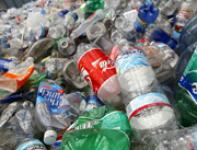
Plastics are embedded in a myriad of modern-day products, from pens, cell phones, and storage containers to car parts, artificial limbs, and medical instruments; unfortunately, there are long-term costs associated with these advances. Plastics do not biodegrade easily. There is a region of the Northern Pacific Ocean, estimated to be roughly the size of Texas, where plastics collect to form an island and cause serious environmental impact. While this is an international problem, in the U.S. we also worry about plastics that end up in landfills and may stay there for hundreds of years. To gain some perspective on the severity of the problem, the first plastic bottle was introduced in 1975 and now, according to some sources, roughly 50 million plastic water bottles end up in U.S. landfills every day.
The United States Environmental Protection Agency (EPA) has asked your team to use mathematical modeling to investigate this problem.
- How big is the problem? Create a model for the amount of plastic that ends up in landfills in the United States. Predict the production rate of plastic waste over time and predict the amount of plastic waste present in landfills10 years from today.
- Making the right choice on a local scale. Plastics aren’t the only problem. So many of the materials we dispose of can be recycled. Develop a mathematical model that a city can use to determine which recycling methods it should adopt. You may consider, but are not limited to:
- providing locations where one can drop off pre-sorted recyclables
- providing single-stream curbside recycling
- providing single-stream curbside recycling in addition to having residents pay for each container of garbage collected
Your model should be developed independent of current recycling practices in the city and should include some information about the city of interest and some information about the recycling method. Demonstrate how your model works by applying it to each of the following cities: Fargo, North Dakota; Price, Utah; Wichita, Kansas.
- How does this extend to the national scale? Now that you have applied your model to cities of varying sizes and geographic locations, consider ways that your model can inform the EPA about the feasibility of recycling guidelines and/or standards to govern all states and townships in the U.S. What recommendations does your model support? Cite any data used to support your conclusions.
Submit your findings in the form of a report for the EPA.
The following references may help you get started:
http://www.epa.gov/epawaste/nonhaz/municipal/index.htm
http://5gyres.org/what_is_the_issue/the_problem/
Reference and other links included on this page were current and valid at time of original posting; if they are no longer valid or live please look for similar or updated links in context with the referenced topic.





